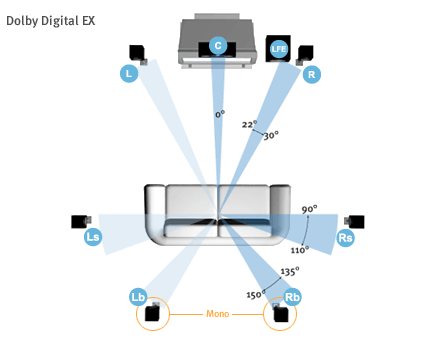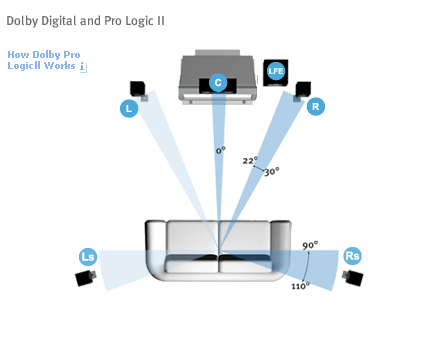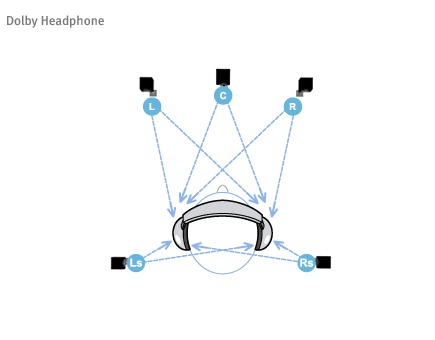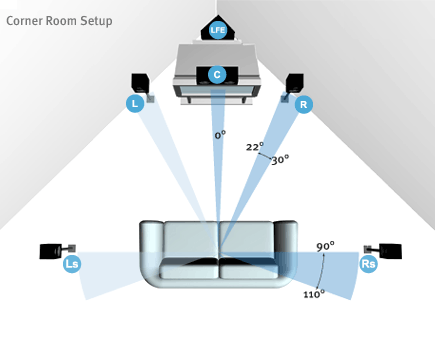|
5.1 Setup
This system has six
channels: five full-range channels, and a low-frequency effects
channel (the .1 of 5.1) usually expressed through a subwoofer. Many
DVDs and digital broadcasts feature a Dolby® Digital
(5.1) soundtrack, so this will give you optimum sound for most
programming. It also most closely approximates the sound in most
cinemas.
6.1 or 7.1 Setup
The most advanced home theater systems feature six (with Center
Back) or seven (with Left Back/Right Back) full-range channels that
allow viewers to take full advantage of Dolby Digital EX soundtracks
and Dolby Pro Logic® IIx matrix-surround decoding
technology. Both of these processes add surround information for
greater realism and more dramatic effects.
Placement Tips
Of course, it's not always possible to place your speakers exactly
as shown. The diagrams give a range of placement angles, so you have
some flexibility. Sometimes you'll have no choice but to mount the
surrounds behind you, but if you follow the guidelines as closely as
you can, you'll have good sound.
Ideally, your front speakers, high-frequency drivers, or tweeters
should be positioned at ear level (when you're seated). Our
recommended height for the surrounds is above ear level, as
soundtracks are likely to be optimized for that location.
Beyond keeping it on the floor, there's no specific rule for placing
the subwoofer, as bass sound is non-directional. However, the amount
of bass may vary depending on room location. You might want to try a
few different places to determine what's best for you (sometimes
moving the speaker even a few inches can change the sound).
Speaker Shopping Tips
Most speaker manufacturers offer complete home theater systems,
usually based on a satellite/subwoofer configuration. You're assured
of speakers that match sonically (and cosmetically). Generally, the
satellite speakers in these systems are shielded, so they can be
placed close to your TV set. If your stereo speakers are not
shielded, don't place them too close to the TV. (They're too close
if the picture starts to distort.)
If you're expanding a stereo system and want to keep the speakers
you have, try to stick with the manufacturer of your current
speakers when you choose your center channel, surrounds and
subwoofer. Most speaker manufacturers can offer advice on
complementary models.
Room Acoustics
The shape of your room and how it's furnished will affect the sound
you hear. For instance, too many bare surfaces can cause reflections
that may add harshness to the sound. Adding carpeting and drapes can
help.
If you have a choice of rooms, avoid ones that are perfectly square
or have one dimension exactly twice another. These rooms can
aggravate resonances that color the sound.
If possible, center your seating area between the surround speakers.
The closer you place a speaker to intersecting room surfaces
(corners, wall and ceiling, wall and floor), the stronger the bass
output. This can help bass-shy speakers, but it can also add too
much bass. Again, just moving a speaker a few inches can often make
a big difference in sound.
|
|








